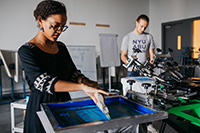-
Academics
-
Admissions
 Your journey to NYUAD starts here. Attend an application workshop or information session.Admissions Events
Your journey to NYUAD starts here. Attend an application workshop or information session.Admissions Events -
Research
-
Campus Life
 Live the possibilities. Be part of a dynamic community of students from over 115 countries.Take a Tour
Live the possibilities. Be part of a dynamic community of students from over 115 countries.Take a Tour - Public Programs
-
About
Exceptional education. World class research. Community-driven.Our Story
- News
- Events
- Social Media Directory
- Press Room
-
- Torch at NYUAD
- Faculty
- Current Students
- Alumni
- عربي
High-Throughput Molecular and Cellular Sorting on a Microfluidic Chip
Prior to any biosensing/detection, an efficient preparation is required to reduce the sample complexity and to increase the detection sensitivity of a biosensor. We utilize colloidal particles to build a high-aspect-ratio biomimetic nanostructure for the separation of biomolecules inside a BioMEMS device. The main advantages of this approach are that the pore size of the membrane can be precisely tuned for different molecules by selecting the proper size of the colloidal particles. Furthermore, the surface of particles can be functionalized prior to the self assembly process inside the microchannel with regard to the surface charge, hydrophobicity and affinity.
This flexibility in surface functionalization of the nanopores could enable to fabricate biomimetic membranes with similar characteristics of biomembranes such as polar surfaces, nonthrombogenic, low antigenic potential and low permeability. Such a biomimetic micro/nanostructure with functionally graded properties could be used to separate DNA/RNA for the next generation DNA sequencing and other biomolecules such as enzyme, carbohydrates and hormones& for bioanalysis. Another application of these biomimetic micro/nanostructures is to extract rare cancer cells from the blood samples or to filter out non-healthy cells in a “human-spleen-on-a-chip”. Finally, this biomimetic membrane could enable new biosensors with nanopores for detecting proteins and other disease biomarkers.
